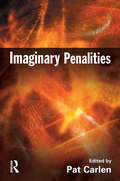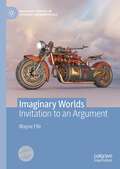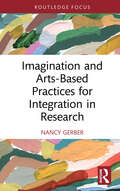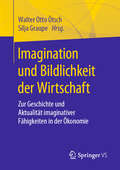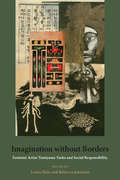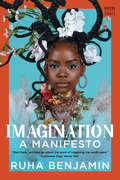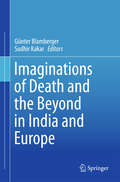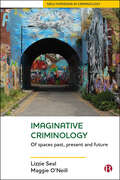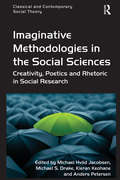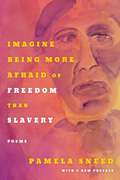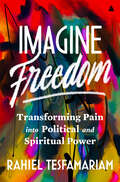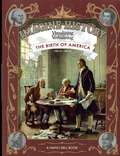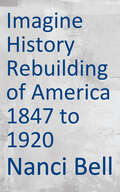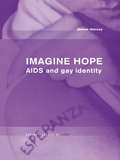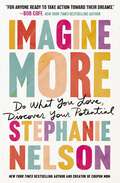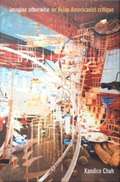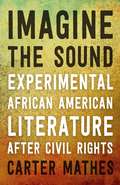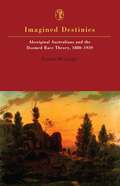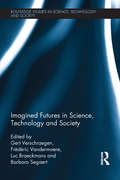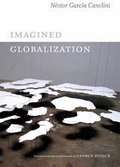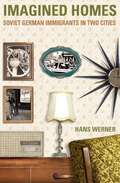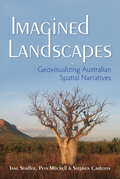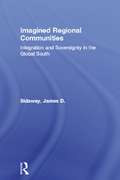- Table View
- List View
Imaginary Penalities
by Pat CarlenThis book is concerned to explore the idea of imaginary penalities and to understand why the management of criminal justice and criminal justice systems has so often reached crisis point. Its underlying theme is that when political strategies of punitive populism are combined with managerialist techniques of social auditing, a new all-encompassing form of governance has emerged - powerless to deliver what it promises but with a momentum of its own and increasingly removed from proper democratic accountability. A highly distinguished international group of contributors explores this set of themes in a variety of different contexts taken from the UK, N. America, Europe and Australia. It will be essential reading for anybody seeking to understand some of the root causes of increasing prison populations, social harms such as recidivism and domestic violence and the increasingly important role of criminal justice within systems of governance.
Imaginary Worlds: Invitation to an Argument (Palgrave Studies in Literary Anthropology)
by Wayne FifeIn this work, the author contends that we should create a comparative framework for the study of imaginary worlds in the social sciences. Making use of extended examples from both science fiction and fantasy fiction, as well as the living movement of steampunk, the reader is invited to an argument about how best to define imaginary worlds and approach them as social locations for qualitative research. It is suggested in this volume that increasing economic and existential forms of alienation fuel the contemporary surge of participation in imaginary worlds (from gaming worlds to young adult novels) and impel a search for more humane forms of social and cultural organization. Suggestions are made about the usefulness of imaginary worlds to social scientists as places for both testing out theoretical formulations and as tools for teaching in our classrooms.
Imagination and Arts-Based Practices for Integration in Research
by Nancy GerberImagination and Arts-Based Practices for Integration in Research explores the philosophical assumptions, defining concepts, and methodological issues related to the introduction of intentional imaginative mental processes and arts-based practices into some or all phases of investigation, and data integration of particular research approaches. Although typically central to mixed, multi-method, and arts-based research, the practice of integrating diverse forms of data might be applied to other research traditions. The integration of data diversity represents a deviation from traditional scientific thinking demanding a dramatic paradigm shift inclusive of multi-dimensional, nondiscursive, aesthetic, rhizomatic, and imaginative mental processes. In this book, imaginative mental processes and arts-based practices are described and illustrated as approaches to investigating, revealing, and understanding the elusive yet essential meanings hidden in the crevices, shadows, and liminal spaces in between diverse data sets leading to integration, illumination, and synthesis. The book will appeal to arts-based, mixed methods, and adventurous researchers. It walks the reader through the revisionist philosophical assumptions and offers aligned methodological suggestions to the induction of imaginative mental processes and arts-based practices into research.
Imagination and Invention (Univocal)
by Gilbert SimondonA radical rethinking of the theory and the experience of mental images Here, in English translation for the first time, is Gilbert Simondon&’s fundamental reconception of the mental image and the theory of imagination and invention. Drawing on a vast range of mid-twentieth-century theoretical resources—from experimental psychology, cybernetics, and ethology to the phenomenological reflections of Sartre and Merleau-Ponty—Imagination and Invention provides a comprehensive account of the mental image and adds a vital new dimension to the theory of psychical individuation in Simondon&’s earlier, highly influential work.Simondon traces the development of the mental image through four phases: first a bundle of motor anticipations, the image becomes a cognitive system that mediates the organism&’s relation to its milieu, then a symbolic and abstract integration of motor and affective experience to, finally, invention, a solution to a problem of life that requires the externalization of the mental image and the creation of a technical object. An image cannot be understood from the perspective of one phase alone, he argues, but only within the trajectory of its progressive metamorphosis.
Imagination und Bildlichkeit der Wirtschaft: Zur Geschichte und Aktualität imaginativer Fähigkeiten in der Ökonomie
by Walter Otto Ötsch Silja GraupeDer vorliegende Band stellt ein erstes Grundlagenwerk zur Imaginationsforschung in der Ökonomie dar. Er erforscht die ökonomische Theoriegeschichte (auch mit Bezug auf die Philosophiegeschichte) und fragt, welche Bilder und Selbstbilder über Menschen, über das wirtschaftliche System und über die Zukunft in ökonomischen Theorien enthalten sind. Wie ist die Beschäftigung mit Imaginationen im Mainstream der Wirtschaftswissenschaften verloren gegangen und wie kann sie wiederbelebt werden?Prof. Dr. Walter Otto Ötsch ist Professor für Ökonomie und Kulturgeschichte an der Cusanus Hochschule für Gesellschaftsgestaltung.Prof. Dr. Silja Graupe ist Professorin für Ökonomie und Philosophie und Leiterin des Instituts für Ökonomie der Cusanus Hochschule für Gesellschaftsgestaltung.
Imagination without Borders: Feminist Artist Tomiyama Taeko and Social Responsibility (Michigan Monograph Series in Japanese Studies #69)
by Laura Hein Rebecca JennisonTomiyama Taeko, a Japanese visual artist born in 1921, is changing the way World War II is remembered in Japan, Asia, and the world. Her work deals with complicated moral and emotional issues of empire and war responsibility that cannot be summed up in simple slogans, which makes it compelling for more than just its considerable beauty. Japanese today are still grappling with the effects of World War II, and, largely because of the inconsistent and ambivalent actions of the government, they are widely seen as resistant to accepting responsibility for their nation’s violent actions against others during the decades of colonialism and war. Yet some individuals, such as Tomiyama, have produced nuanced and reflective commentaries on those experiences, and on the difficulty of disentangling herself from the priorities of the nation despite her lifelong political dissent. Tomiyama’s sophisticated visual commentary on Japan’s history—and on the global history in which Asia is embedded—provides a compelling guide through the difficult terrain of modern historical remembrance, in a distinctively Japanese voice.
Imagination: A Manifesto (A Norton Short #0)
by Ruha Benjamin“Start here, and then go about the work of imagining the world anew.” —Arimeta Diop, Vanity Fair In this revelatory work, Ruha Benjamin calls on us to take imagination seriously as a site of struggle and a place of possibility for reshaping the future. A world without prisons? Ridiculous. Schools that foster the genius of every child? Impossible. Work that doesn’t strangle the life out of people? Naive. A society where everyone has food, shelter, love? In your dreams. Exactly. Ruha Benjamin, Princeton University professor, insists that imagination isn’t a luxury. It is a vital resource and powerful tool for collective liberation. Imagination: A Manifesto is her proclamation that we have the power to use our imaginations to challenge systems of oppression and to create a world in which everyone can thrive. But obstacles abound. We have inherited destructive ideas that trap us inside a dominant imagination. Consider how racism, sexism, and classism make hierarchies, exploitation, and violence seem natural and inevitable—but all emerged from the human imagination. The most effective way to disrupt these deadly systems is to do so collectively. Benjamin highlights the educators, artists, activists, and many others who are refuting powerful narratives that justify the status quo, crafting new stories that reflect our interconnection, and offering creative approaches to seemingly intractable problems. Imagination: A Manifesto offers visionary examples and tactics to push beyond the constraints of what we think, and are told, is possible. This book is for anyone who is ready to take to heart Toni Morrison’s instruction: “Dream a little before you think.”
Imaginations of Death and the Beyond in India and Europe
by Sudhir Kakar Günter BlambergerThis volume explores current images of afterlife/afterdeath and the presence of the dead in the imaginations of the living in Indian and European traditions. Specifically, it focuses on the deepest and most fundamental uncertainty of human existence---the awareness of human mortality, on which depends any assignment of meaning to earthly existence as also to notions of worldly and otherworldly salvation. This central idea is addressed in the literature, arts, audiovisual media and other cultural artefacts of the two traditions. The chapters are based on two main assumptions: First, that one cannot report on the direct experience of death; so it is only possible to speak allegorically of it. Second, in contemporary Western societies, marked by structural atheism, people look at literature, the arts and mass media to study their depiction and reading of traditionally religious questions of disease, death and the Beyond. This is in contrast to Asian civilizations whose preoccupation with death and Beyond is persistent and perhaps central to the civilizations’ highest thought. The chapters cover a wide spectrum of disciplinary approaches, from psychoanalysis to religious, anthropological, literary and film studies, from sociology and philosophy to art history, and address issues of unsettling power: comforting illusions of afterlife; the relations between afterlife and fertility; visions of technological immortalization of mankind; the problem of thinking about death after the “death of God”; socialist utopias of bodily immortality; fear of Hell and punishment; different concepts in relating the living and the dead; near-death experiences; and cultural practices of spiritualism, occultism and suicide.
Imaginative Criminology: Of Spaces Past, Present and Future (New Horizons in Criminology)
by Maggie O'Neill Lizzie SealThis distinctive and engaging book proposes an imaginative criminology, focusing on how spaces of transgression are lived, portrayed and imagined. These include spaces of control or confinement, including prison and borders, and spaces of resistance. Examples range from camps where asylum seekers and migrants are confined, to the exploration of deviant identities and the imagined spaces of surveillance and control in young adult fiction. Drawing on oral history, fictive portrayals, walking methodologies, and ethnographic and arts-based research, the book pays attention to issues of gender, sexuality, age, ethnicity, mobility and nationality as they intersect with lived and imagined space.
Imaginative Methodologies in the Social Sciences: Creativity, Poetics and Rhetoric in Social Research (Classical and Contemporary Social Theory)
by Michael Hviid Jacobsen Anders Petersen Michael S. DrakeImaginative Methodologies in the Social Sciences develops, expands and challenges conventional social scientific methodology and language by way of literary, poetic and other alternative sources of inspiration, as sociologists, social workers, anthropologists, criminologists and psychologists all rethink, provoke and reignite social scientific methodology. Challenging the mainstream orthodoxy of social scientific methodology, which closely guards the boundaries between the social sciences and the arts and humanities, this volume reveals that authors and artists are often engaged in projects parallel to those of the social sciences and vice versa, thus demonstrating that artistic and cultural production does not necessarily constitute a specialist field, but is in fact integral to social reality. As such, it will be of interest to scholars and students in the social sciences and across the arts and humanities working on the philosophy of social science, methodology, social theory, creativity, poetics, pedagogy and other related topics.
Imagine Being More Afraid of Freedom than Slavery
by Pamela SneedAn incendiary literary work more relevant now than ever.“if anger were an ax/it would split me open/and if this is a sermon/let it be my granddaddy’s sermon/my grandmother’s foottapping/steady rocking/choir singing” —from "It Is Not a New Age"First published in 1998, Imagine Being More Afraid of Freedom than Slavery is the debut collection by acclaimed poet and performer Pamela Sneed. Provocative and potent, it tackles the political and personal issues of enslavement, sexuality, emotional trauma, and abuse. These poems chart the journey of an artist trying to escape cycles of dependency and reclaim lost self and identity. Drawing parallels to Harriet Tubman’s journey on the Underground Railroad, Sneed’s explorations of the woods are a metaphor and emotional path one must explore to attain self-ownership. Sneed’s poems are bound by the search for love, freedom, and justice—from images of lesbian love to Emmet Till’s bloated body, they offer a raging cry and a roadmap for those interested in transforming the personal into social justice and abolitionist practices.
Imagine Freedom: Transforming Pain into Political and Spiritual Power
by Rahiel TesfamariamA social activist, journalist, public theologian, and international speaker who has become a powerful and brilliant voice of her generation offers a bold path to liberation and healing for people of African descent struggling in the shadows of the American Dream. The United States is at a critical juncture in its history. Not since the 1960s has the nation been so racially divided. White supremacy remains America’s Achilles’ heel—a moral failure that haunts us and holds us back from being the great nation we profess. For centuries, people of African descent have endured unimaginable hatred and discrimination which has manifested in pain and trauma passed from generation to generation. To break free from this historical cycle of suffering and be truly free at last, Black and brown people must reimagine ourselves, our communities, this country, and our relationship to Africa.Weaving storytelling, socioeconomic analysis, and cultural criticism with the spiritual and political threads of liberation theology and Pan Africanism, Imagine Freedom empowers us to begin the difficult but necessary work of decolonizing our minds and overcoming the lies we have been told about ourselves for centuries. Sobering and inspiring, filled with despair and hope, Rahiel Tesfamariam dares us to see the world through a larger historical and global lens— to understand how our quests for freedom and healing are intrinsically connected to our past, present, and future. By widening our vision, we discover new ways of imagining self, community, nation, and world, and most importantly, a new way to achieve the freedom that has been too long denied.
Imagine History Visualizing and Verbalizing: The Birth of America 1492 - 1851
by Nanci BellWe can experience the richness of history with our imagery, but more importantly our imagery is the sensory mechanism that enables us to comprehend history and embed it into our memory. <p><p> The content in this book is uniquely written to help students visualize the gestalt and key details needed for recall, understanding, and higher order thinking.
Imagine History: Rebuilding of America 1847 to 1920
by Nanci BellWe can experience the richness of history with our imagery, but more importantly our imagery is the sensory mechanism that enables us to comprehend history and embed it into our memory. The content in this book is uniquely written to help students visualize the gestalt and key details needed for recall, understanding, and higher order thinking.
Imagine More: Do What You Love, Discover Your Potential
by Stephanie NelsonDiscouraged that you will never fulfill your dreams? Stephanie Nelson, creator of the wildly successful Coupon Mom movement, provides a road map to achieving dreams that feel too big to come true and using your unique gifts to create a positive impact on the world. For those who feel stuck in life, unable to make progress toward your deepest hopes and dreams, Stephanie Nelson brings a practical roadmap to reaching your full potential. The creator of the Coupon Mom and jump-starter of the coupon craze that started in 2008 with the recession, Stephanie can relate to holding onto dreams that seem bigger than your abilities. Using her story to unpack life lessons, she shares a path to banish fear and embrace opportunity, develop a vision and pursue dreams, identify God's plan to use your abilities to help others, and build community by including others in your success. It's never too late to imagine more, chase your dreams, and have an impact on the world through using your unique gifts and talents, and Stephanie will show readers how to exchange their ordinary for God's extraordinary. Imagine More is a guide for anyone who wants to use their passions and skills to benefit others and fulfill their most cherished dreams.
Imagine Otherwise: On Asian Americanist Critique
by Kandice ChuhImagine Otherwise is an incisive critique of the field of Asian American studies. Recognizing that the rubric "Asian American" elides crucial differences, Kandice Chuh argues for reframing Asian American studies as a study defined not by its subjects and objects, but by its critique. Toward that end, she urges the foregrounding of the constructedness of "Asian American" formations and shows how this understanding of the field provides the basis for continuing to use the term "Asian American" in light of--and in spite of--contemporary critiques about its limitations. Drawing on the insights of poststructuralist theory, postcolonial studies, and investigations of transnationalism, Imagine Otherwise conceives of Asian American literature and U. S. legal discourse as theoretical texts to be examined for the normative claims about race, gender, and sexuality that they put forth. Reading government and legal documents, novels including Carlos Bulosan's America Is in the Heart, John Okada's No-No Boy, Chang-rae Lee's A Gesture Life, Ronyoung Kim's Clay Walls, and Lois Ann Yamanaka's Blu's Hanging, and the short stories "Immigration Blues" by Bienvenido Santos and "High-Heeled Shoes" by Hisaye Yamamoto, Chuh works through Filipino American and Korean American identity formation and Japanese American internment during World War II as she negotiates the complex and sometimes tense differences that constitute 'Asian America' and Asian American studies.
Imagine the Sound: Experimental African American Literature after Civil Rights
by Carter MathesThe post–Civil Rights era was marked by an explosion of black political thought and aesthetics. Reflecting a shifting horizon of expectations around race relations, the unconventional sounds of free jazz coupled with experimental literary creation nuanced the push toward racial equality and enriched the possibilities for aesthetic innovation within the Black Arts Movement. In Imagine the Sound, Carter Mathes demonstrates how African American writers used sound to further artistic resistance within a rapidly transforming political and racial landscape. While many have noted the oral and musical qualities of African American poetry from the post–Civil Rights period, Mathes points out how the political implications of dissonance, vibration, and resonance produced in essays, short stories, and novels animated the ongoing struggle for equality. Situating literary works by Henry Dumas, Larry Neal, and Toni Cade Bambara in relation to the expansive ideas of sound proposed by free jazz musicians such as Marion Brown and Sun Ra, not only does this book illustrate how the presence of sound can be heard and read as political, but it recuperates critically neglected, yet important, writers and musicians. Ultimately, Mathes details how attempts to capture and render sound through the medium of writing enable writers to envision alternate realities and resistance outside of the linear frameworks offered by the Civil Rights and Black Power movements.In precise and elegant prose, Mathes shows how in conceptualizing sound, African American writers opened up the political imaginations of their readers. By exploring this intellectual convergence of literary artistry, experimental music, and sound theory, Imagine the Sound reveals how taking up radically new forms of expression allows us to speak to the complexities of race and political resistance.
Imagined Destinies: Aboriginal Australians and the Doomed Race Theory, 1880–1939
by Russell McGregorWhite Australians once confidently—if regretfully—believed that the Aboriginal people were doomed to extinction. Even in the 1950s, Australian children were still being taught that the Australian Aboriginals were a dying race who would eventually disappear from the face of the earth. In Imagined Destinies, Russell McGregor explores the origins and the gradual demise of the 'doomed race' theory, which was unquestioned in nineteenth-century European thinking and remained uncontested until the 1930s. White perceptions of Australia's indigenous people and their future had been shaped by Enlightenment ideas about progress, Darwin's new theories on the survival of the fittest, and other European philosophical concepts. Imagined Destinies provides a challenging analysis and history of an idea which has exerted a powerful influence over white Australian attitudes to, and policies for, Aboriginal people. Indeed, its long shadow may still be with us.
Imagined Futures in Science, Technology and Society (Routledge Studies in Science, Technology and Society)
by Gert Verschraegen, Frédéric Vandermoere, Luc Braeckmans and Barbara SegaertImagining, forecasting and predicting the future is an inextricable and increasingly important part of the present. States, organizations and individuals almost continuously have to make decisions about future actions, financial investments or technological innovation, without much knowledge of what will exactly happen in the future. Science and technology play a crucial role in this collective attempt to make sense of the future. Technological developments such as nanotechnology, robotics or solar energy largely shape how we dream and think about the future, while economic forecasts, gene tests or climate change projections help us to make images of what may possibly occur in the future. This book provides one of the first interdisciplinary assessments of how scientific and technological imaginations matter in the formation of human, ecological and societal futures. Rooted in different disciplines such as sociology, philosophy, and science and technology studies, it explores how various actors such as scientists, companies or states imagine the future to be and act upon that imagination. Bringing together case studies from different regions around the globe, including the electrification of German car infrastructure, or genetically modified crops in India, Imagined Futures in Science, Technology and Society shows how science and technology create novel forms of imagination, thereby opening horizons toward alternative futures. By developing central aspects of the current debate on how scientific imagination and future-making interact, this timely volume provides a fresh look at the complex interrelationships between science, technology and society. This book will be of interest to postgraduate students interested in Science and Technology Studies, History and Philosophy of Science, Sociology, Cultural Studies, Anthropology, Political Sciences, Future Studies and Literary Sciences.
Imagined Globalization
by George Yúdice Néstor García CancliniA leading figure in cultural studies worldwide, Néstor García Canclini is a Latin American thinker who has consistently sought to understand the impact of globalization on the relations between Latin America, Europe, and the United States, and among Latin American countries. In this book, newly available in English, he considers how globalization is imagined by artists, academics, migrants, and entrepreneurs, all of whom traverse boundaries and, at times, engage in conflicted or negotiated multicultural interactions.García Canclini contrasts the imaginaries of previous migrants to the Americas with those who live in transnational circuits today. He integrates metaphor and narrative, working through philosophical, anthropological, and socioeconomically grounded interpretations of art, literature, crafts, media, and other forms of expression toward his conclusion that globalization is, in important ways, a collection of heterogeneous narratives. García Canclini advocates global imaginaries that generate new strategies for dealing with contingency and produce new forms of citizenship oriented toward multiple social configurations rather than homogenization. This edition of Imagined Globalization includes a significant new introduction by George Yúdice and an interview in which the cultural theorist Toby Miller and García Canclini touch on events including the Arab Spring and Occupy Wall Street.
Imagined Homes: Soviet German Immigrants in Two Cities (Studies in Immigration and Culture #1)
by Hans WernerImagined Homes: Soviet German Immigrants in Two Cities is a study of the social and cultural integration of two migrations of German speakers from Eastern Europe and the Soviet Union to Winnipeg, Canada in the late 1940s, and Bielefeld, Germany in the 1970s. Employing a cross-national comparative framework, Hans Werner reveals that the imagined trajectory of immigrant lives influenced the process of integration into a new urban environment. Winnipeg’s migrants chose a receiving society where they knew they would again be a minority group in a foreign country, while Bielefeld’s newcomers believed they were “going home” and were unprepared for the conflict between their imagined homeland and the realities of post-war Germany. Werner also shows that differences in the way the two receiving societies perceived immigrants, and the degree to which secularization and the sexual and media revolutions influenced these perceptions in the two cities, were crucially important in the immigrant experience.
Imagined Landscapes: Geovisualizing Australian Spatial Narratives (The Spatial Humanities)
by Jane Stadler Stephen Carleton Peta MitchellImagined Landscapes teams geocritical analysis with digital visualization techniques to map and interrogate films, novels, and plays in which space and place figure prominently. Drawing upon A Cultural Atlas of Australia, a database-driven interactive digital map that can be used to identify patterns of representation in Australia's cultural landscape, the book presents an integrated perspective on the translation of space across narrative forms and pioneers new ways of seeing and understanding landscape. It offers fresh insights on cultural topography and spatial history by examining the technical and conceptual challenges of georeferencing fictional and fictionalized places in narratives. Among the items discussed are Wake in Fright, a novel by Kenneth Cook, adapted iconically to the screen and recently onto the stage; the Australian North as a mythic space; spatial and temporal narrative shifts in retellings of the story of Alexander Pearce, a convict who gained notoriety for resorting to cannibalism after escaping from a remote Tasmanian penal colony; travel narratives and road movies set in Western Australia; and the challenges and spatial politics of mapping spaces for which there are no coordinates.
Imagined Regional Communities: Integration and Sovereignty in the Global South (Routledge Studies in Human Geography #Vol. 5)
by James D. SidawayImagined Regional Communities provides an original approach to thinking about the processes of regional integration. Focusing mostly on communities in Africa, Asia and Latin America, it develops detailed case studies based on archives, interviews and critical readings of existing texts. These case-studies are related to each other and the overall themes of the book, so that a set of narratives and theoretical elaborations emerge, that critically reformulate understandings of regional communities, statehold and sovereignty.
Imaging Wisdom: Seeing and Knowing in the Art of Indian Buddhism (Routledge Critical Studies In Buddhism Ser. #No. 6)
by Jacob N KinnardThis book contributes to the history of religions and Buddhist studies fields by focussing on what is a far too frequently ignored aspect of religious experience: visual images.
